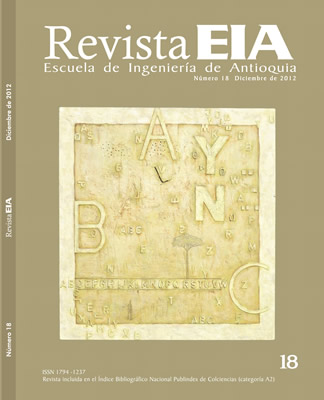MODELING AND SIMULATION OF A BATCH DISTILLATION COLUMN FOR RECOVERING LIMONENE EPOXIDE (MODELADO Y SIMULACIÓN DE UNA COLUMNA DE DESTILACIÓN POR LOTES PARA RECUPERAR EPÓXIDO DE LIMONENO)
MODELING AND SIMULATION OF A BATCH DISTILLATION COLUMN FOR RECOVERING LIMONENE EPOXIDE (MODELADO Y SIMULACIÓN DE UNA COLUMNA DE DESTILACIÓN POR LOTES PARA RECUPERAR EPÓXIDO DE LIMONENO)


This work is licensed under a Creative Commons Attribution-NonCommercial-NoDerivatives 4.0 International License.
Copyright statement
The authors exclusively assign to the Universidad EIA, with the power to assign to third parties, all the exploitation rights that derive from the works that are accepted for publication in the Revista EIA, as well as in any product derived from it and, in in particular, those of reproduction, distribution, public communication (including interactive making available) and transformation (including adaptation, modification and, where appropriate, translation), for all types of exploitation (by way of example and not limitation : in paper, electronic, online, computer or audiovisual format, as well as in any other format, even for promotional or advertising purposes and / or for the production of derivative products), for a worldwide territorial scope and for the entire duration of the rights provided for in the current published text of the Intellectual Property Law. This assignment will be made by the authors without the right to any type of remuneration or compensation.
Consequently, the author may not publish or disseminate the works that are selected for publication in the Revista EIA, neither totally nor partially, nor authorize their publication to third parties, without the prior express authorization, requested and granted in writing, from the Univeridad EIA.
Show authors biography
Aspen Plus and MATLAB software simulation tools were employed for modeling, simulation and optimization of a distillation process to recover limonene epoxide from a liquid mixture containing limonene + acetonitrile + water + limonene epoxide. This mixture is obtained from limonene epoxidation over PW-Amberlite using aqueous hydrogen peroxide as oxidant and acetonitrile as solvent. Analyses of residue curve maps indicate that batch distillation columns of inverse configuration are adequate to separate limonene epoxide. The model parameters, i.e., the number of stages (8) and the reflux ratio (3,1) were determined by steady state simulations with short-cut models and rigorous models from Aspen Plus. Aspen Plus simulation of the batch distillation operation showed that it is possible to recover up to 95 % limonene epoxide with a molar fraction of 0,97 after 7,5 h. For comparison purposes, the batch distillation operation was also simulated with a semi-rigorous MATLAB model and similar results were obtained.
Resumen: Se emplearon herramientas de software de simulación como Aspen Plus y MATLAB para el modelado, simulación y optimización de un proceso de destilación para recuperar epóxido de limoneno a partir de una mezcla líquida que contiene limoneno + acetonitrilo + agua + epóxido de limoneno. Esta mezcla se obtiene de la epoxidación de limoneno sobre PW-Amberlita utilizando peróxido de hidrógeno acuoso como oxidante y acetonitrilo como disolvente. Los análisis de curvas de composición residual indicaron que las columnas de destilación por lotes de configuración inversa son adecuadas para separar el epóxido de limoneno. Los parámetros del modelo, como el número de etapas (8) y la relación de reflujo (3,1) se determinaron mediante simulaciones de estado estacionario con modelos cortos y rigurosos de Aspen Plus. La simulación del equipo por lotes en Aspen Plus mostró que es posible recuperar hasta el 95 % del epóxido de limoneno con una fracción molar de 0,97 después de 7,5 h. Con fines comparativos, la destilación por lotes también se simuló con un modelo semirriguroso construido en MATLAB, con el cual se lograron resultados similares.
Article visits 405 | PDF visits
